After having used both the Nakama series and Yookoso series in college, learning Japanese seemed to revolve around tests of grammar, vocabulary, and kanji study. The instructors used few if any speaking assessments, and use of technology for learning was next to nil. After college, I taught beginner Japanese at a community center and the curriculum they were utilizing never even got past basic phrases. Lesson 1 was repeated almost every week because a new student with absolutely no knowledge of Japanese would show up. Loyal students never really progressed in their learning.
This wonderful curriculum allowed students to try any topic without needing to have learned the previous topic's content as a prerequisite.
However, all of that changed with the introduction of the Marugoto books. With the curriculum's start-anywhere design, we were able to progress through the book week after week regardless of the number of new faces. This wonderful curriculum allowed students to try any topic without needing to have learned the previous topic's content as a prerequisite. In addition, the highly interactive curriculum allowed for both input and output practice of the language itself. No longer were students just copying notes from the board without saying a word. Now, they were getting into groups, practicing vocabulary and dialogues, and using the online resources at home to practice what they learned on their own time. For our small classes, this was a godsend.
In this article, I will break down all of the levels of the Marugoto books and give you a brief preview into what you will be getting when purchasing each text. All associated websites and digital features will be discussed as well. Before that, I will briefly talk about Marugoto's more remarkable points as well as the overall organization and content.
- What Makes Marugoto Stand Out?
- Level-Based Learning
- Marugoto: Starter (A1)
- Marugoto: Elementary 1 (A2)
- Marugoto: Elementary 2 (A2)
- Marugoto: Pre-Intermediate (A2/B1)
- Marugoto: Intermediate 1 (B1)
- Marugoto: Intermediate 2 (B1)
- The Verdict: Best Japanese Learning Curricula in Group Settings
What Makes Marugoto Stand Out?
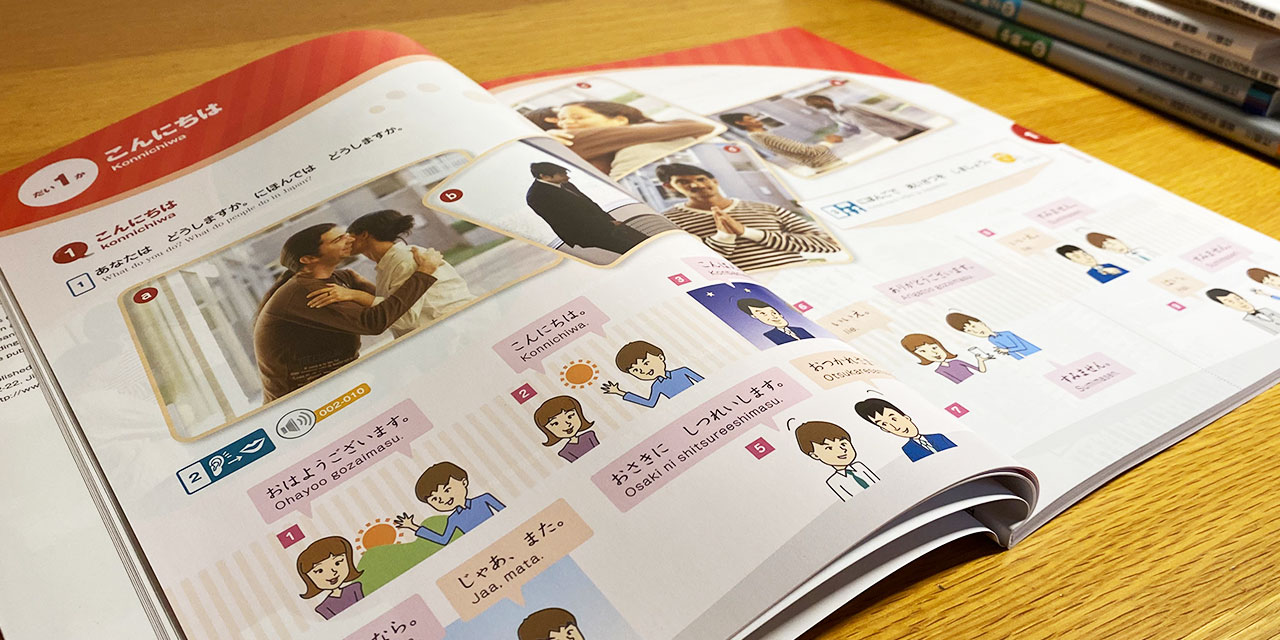
While a variety of levels and books are nice, Marugoto is especially notable for its substantial use of colorful content, illustrations, and photographs. Quality content audio — and plenty of audio exercises — are included as well. The first three levels also have high-class accompanying websites where users can review grammar, practice expressions and vocabulary, study Japanese characters, and even view videos about Japanese culture and life in Japan — my favorite part! Furthermore, everything just feels fresh and modern. You will find modern vocabulary related to things like social networking, emails, texts, mental health, globalization, industry, etc.
Another plus is the wide range of topics taught using a Japanese cultural context approach: healthy living, school, transportation, work life, holidays, technology, theater, shopping, news, emergencies, and more. These topics were set by the JF Standards — each book featuring a number of relevant ones. Since the series was originally designed for foreigners living in Japan, you will notice a lack of content typical of many popular Japanese language textbooks. I'm talking about college class-centered things like, "What's your major?" and "I'm studying economics." Additionally, lessons are not (necessarily) progressive, which means you can jump from one lesson to another without much trouble at all.

And the inclusion of clear goal markers — called "Can-Dos" by the curriculum — helps students really see what they will get out of their lesson. I've listed below some of the Can-Dos you will see when using the Marugoto books (these have been randomly pulled from all of the Marugoto textbooks).
- I can talk to someone about my family using a photo.
- I can say what kind of home I live in.
- I can write a birthday card.
- I can talk about where to shop for something I want.
- I can tell a friend what a place that he/she is interested in is like and what to be careful about, using a map.
- I can talk briefly about what I usually do to stay healthy.
- I can read emails of apology and their replies and understand the writer's feelings.
- I can ask someone for help in an emergency.
- I can read a recipe for a dish and, for example, the ingredients, how it is made, and the points one should be careful of.
- I can write an email of inquiry to a martial arts class, for example, asking how to take a class.
- I can listen to a short news item about a familiar topic and understand the main point.
- I can take part in a conversation about another country's history or culture.
With a strong lineup of nine textbooks, the Marugoto series is able to accommodate both beginners and intermediate students.
Living in Japan, I can definitely attest to the usefulness of these skills — long-term foreigners here are bound to ask someone for help in an emergency at some point. And given Japan's apology-centered culture, being able to read emails of apology in the language is essential. These skills (and many others introduced by the curriculum) were chosen by Marugoto's team, The Japan Foundation, to help expats living in Japan learn Japanese efficiently and completely (hence the name Marugoto, meaning wholly or completely). All of this is done through a Japanese cultural context. In other words, the words, phrases, and grammar you will learn are drawn from contexts and situations that are native to life in Japan.
And while all of this is nice, the textbook series may be difficult for a self-learner to navigate and implement by themselves. Having said that, the Marugoto curriculum is truly ideal for an instructor-guided environment. The series' extensive use of digital resources and portfolios helps to bolster learning and keep students engaged. And with a strong lineup of nine textbooks, the Marugoto series is able to accommodate both beginners and intermediate students. Furthermore, any instructors reading this will be delighted to hear that there is an abundance of extra resources that one can find online to beef up the learning. From extra practice problems to supplementary topics and more — it can all be found at Marugoto's main page.
Level-Based Learning
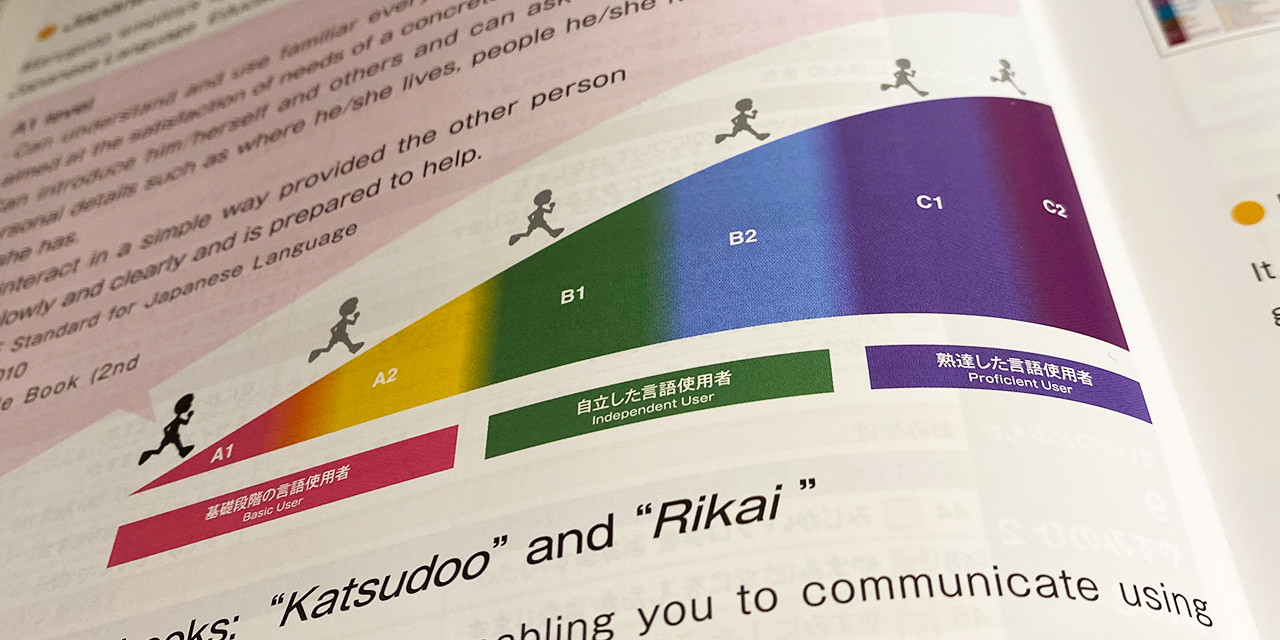
One of Marugoto's strongest points is its variety of content among a large range of proficiency levels. There are, as you might have guessed, a few different ways to measure proficiency in a language. One of the more popular methods is the Common European Framework of Reference for Language (or CEFR, for short). Based on the CEFR, the Japan Foundation created a language proficiency framework tailored to Japanese: the JF Standard for Japanese-Language Education (JFS). These two language proficiency frameworks are the basis for Marugoto's level breakdown.
The CEFR divides overall language proficiency into six categories: A1, A2, B1, B2, C1, and C2. A1 speakers of a language know only the very basics of that language while C2 speakers are exceptionally fluent and can use that language the same as (or even better than) an average native speaker. The Marugoto series claims to cover levels A1 to B1, but their highest level is also considered to be at the B2 level by some. Marugoto books also provide explanations for each level. I will provide a short summary of each level based on the book's description.
One of Marugoto's strongest points is its variety of content among a large range of proficiency levels.
- A1 - Can understand and state short, rehearsed phrases
- A2 - Can give or listen to a short, rehearsed presentation on a familiar subject
- B1 - Can give or listen to a prepared, straightforward presentation on a familiar topic within his/her field
- B2 - Can give or listen to a clear, prepared presentation
- C1 - Can give a clear, well-prepared presentation on a complex topic
- C2 - Can present a complex topic confidently and articulately to an audience unfamiliar with it
The CEFR and JFS also provide so-called "Can-Do" statements that detail what linguistic skills and abilities a user should be able to do in their target language. These Can-Do statements have been recently integrated into a number of other curricula and linguistic programs. The Marugoto texts integrate Can-Do statements all throughout their books. Utilizing these proficiency markers, users can even assess their own progress and create a portfolio to document their learning.
And while I could go on and on about how these books are organized and the logic behind their design, it would probably be more productive to read about it yourself here.
So without further ado, let's get into the nitty-gritty of each book.
Marugoto: Starter (A1)
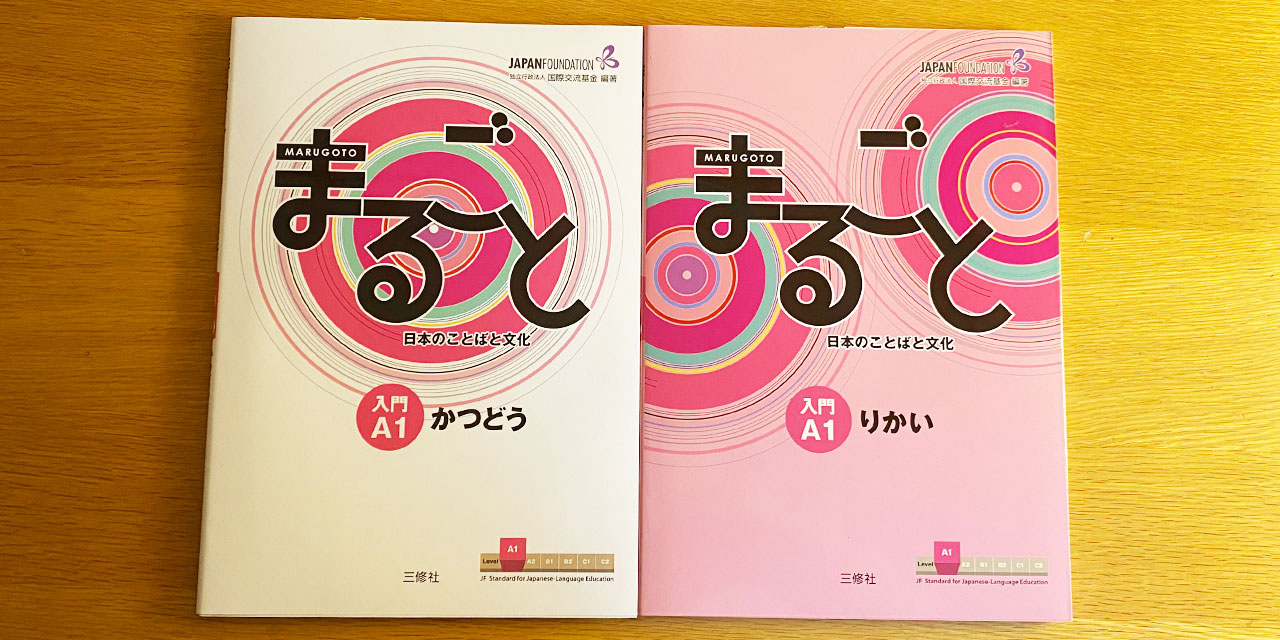
The first set of textbooks in the Marugoto lineup are the Starter (A1) books. There are two pink-covered books that are designed for absolute beginners. This means anyone can use them without any prior knowledge of the Japanese language. You don't even need to know the ABCs of Japanese — hiragana, katakana, and some basic kanji — to start this first set of the Marugoto series.
The two books are called Rikai (which means understanding) and Katsudoo (which means activities). Content-wise, they are essentially the same. The number of topics and lessons are the same, and the lessons in each book mirror one another. The difference is the linguistic focus of each book. In Katsudoo, you will practice your listening and speaking more. In Rikai, you will practice reading, writing, and Japanese characters more.
The Marugoto website says that you can use both books simultaneously or even separately. In my experience using Marugoto, serious learners in a classroom setting would get the most benefit from using both books. Of course, if you are just looking to level up your speaking and listening skills, then only focusing on Katsudoo is fine. And if you just want to practice reading and writing more, then Rikai is all you really need.
Content is broken up into topics (chapters) and each topic contains two lessons. Each lesson has a variety of activities and features that help learners practice listening, speaking, conversation, reading, and writing. At the end of every topic in the Katsudoo book, there is a whole section dedicated to life and culture in Japan that is based on the topic. This is explored further by culture videos you can view on the accompanying website, which we'll get into more later.
You don't even need to know the ABCs of Japanese — hiragana, katakana, and some basic kanji — to start this first set of the Marugoto series.
After getting through the first five topics, there is a "Test and Reflection" section. Another Test and Reflection is presented at the very end of the books as well. This is probably more important for instructors who want to implement assessments into the course. An actual assessment is not presented in these sections; they only describe what kinds of questions and activities a student would see on an exam based on the Marugoto curriculum. And while the recommended test section timing and questions differ between each book, each test is still recommended to take place in 120 minutes. The Katsudoo test recommends activities that assess a student's proficiency in Japanese characters, reading, and speaking skills. The Rikai test suggests test activities that assess a learner's listening comprehension, kanji recognition skills, particle knowledge, word ordering, passage-based reading comprehension, and listening comprehension. The Rikai test seems to be more in-depth and covers more areas of language. Some of these recommended activities are also similar to what one would see on the Japanese Language Proficiency Test (JLPT). However, no actual test questions are presented in the books; it is up to the instructor to make and conduct all assessments and activities. But of course, any self-learners out there could use the example questions to make their own assessments and test themselves at a later time.
Now that I walked you through the organization of the textbooks, you might be wondering what kind of topics Marugoto: Starter (A1) covers. Can-Dos for the A1 level include basic interactive skills like self-introductions and asking questions about others. Marugoto: Starter (A1) features skills such as "talk briefly about your family" or "talk about your favorite food." For more details, check the table of contents for Katsudoo and Rikai to see if it fits your level and what you want to actually get out of it.
Digital Content for Marugoto: Starter (A1)
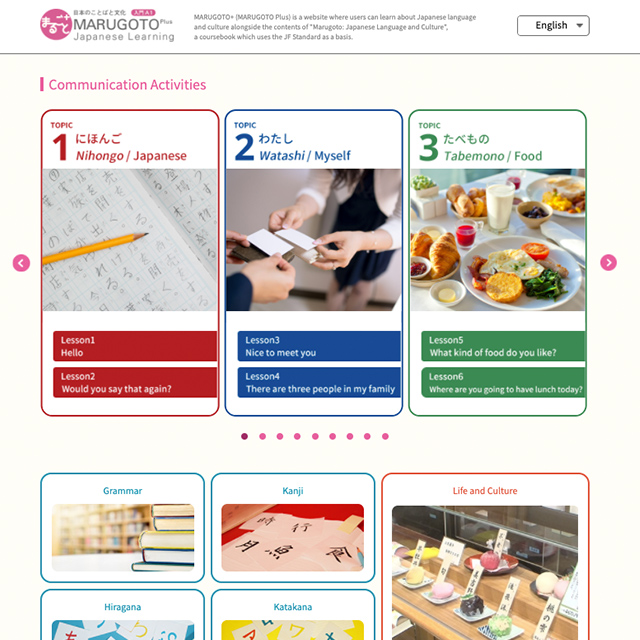
The accompanying website, A1 MarugotoWeb, is a great place to practice what you've learned at home or elsewhere on your own time. Each Can-Do is broken down into activities you can do on the site. Can-Do 10, for example, gives you a "Speaking Practice" video which illustrates how to ask someone if they would like to have a drink of coffee and how one can properly respond in Japanese. Scrolling down a bit, you can find the "Challenge" video, which places you in a similar position, pausing to allow you to respond to the question: コーヒー、のみますか? (Do you want some coffee?) The website also has pages dedicated to grammar practice, hiragana practice, katakana practice, kanji practice, and even a page with short videos about life and culture in Japan. The life and culture videos were always a favorite for my students and were the center of a lot of discussion in our classes.
Useful Links
- Accompanying Website: A1 MarugotoWeb
- Accompanying Wordbook: Wordbook
- Can-Do List: Katsudoo and Rikai
- Vocabulary Index: Katsudoo and Rikai
- Phrase Index: Katsudoo and Rikai
- Audio Files: Katsudoo and Rikai (Account login required.)
- Kanji Index: Rikai
- Amazon.co.jp:
- Amazon.com:
Marugoto: Elementary 1 (A2)
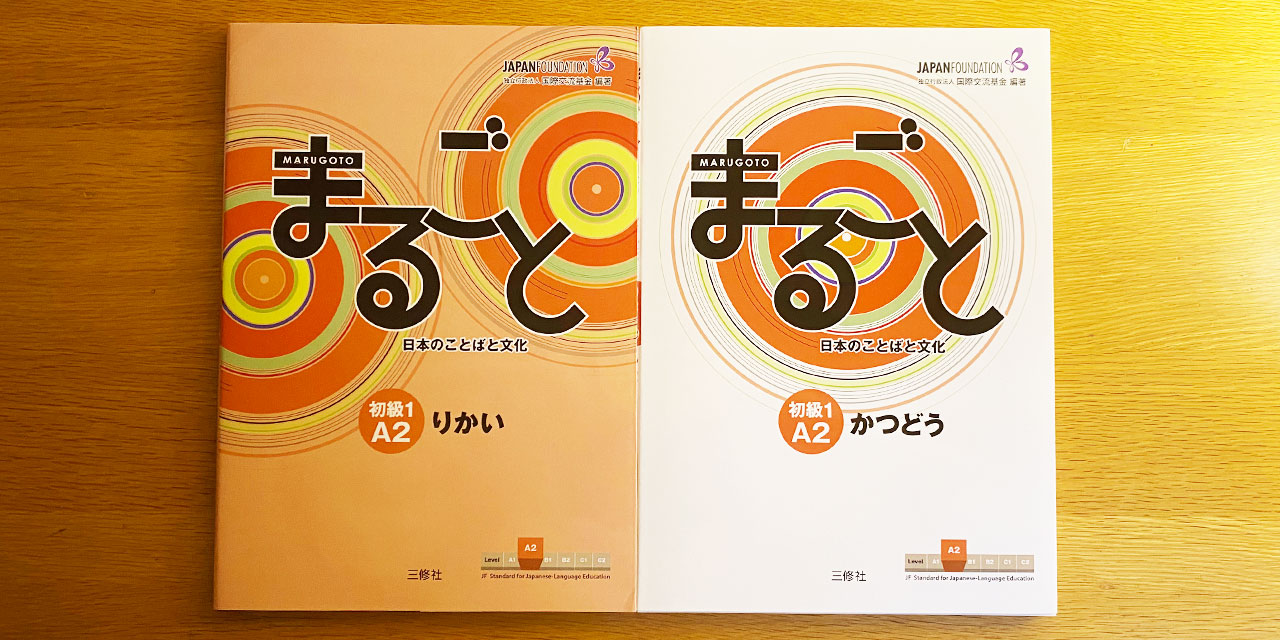
The next set of books is very similar to the Starter set in terms of organization and digital resources. There are two books (also called Katsudoo and Rikai) with one focusing on linguistic output and the other focusing on linguistic input. The main difference is a jump in difficulty and complexity of topics. Oh, and romaji is gone as well. Plus, an extra "Discover the Rule" feature has been introduced. In Discover the Rule sections, students will attempt to pick out and understand a particular grammar point that the lesson highlights. The Test and Reflection sections also reappear in the same way that they did with the previous set.
Of course, the Elementary 1 (A2) books are a step up in difficulty from the A1 books. You will learn slightly more complicated grammar patterns, words, and phrases. Some skills that the Elementary 1 (A2) books promote include things like, "describe features of buildings seen in the distance" and "read a message from a colleague in the overseas office when you return home from a business trip." And despite it not being a test-prep series, it is also worth noting that by the time you finish this level, you should be well prepared to pass the N5 level of the JLPT.
Digital Content for Elementary 1 (A2)
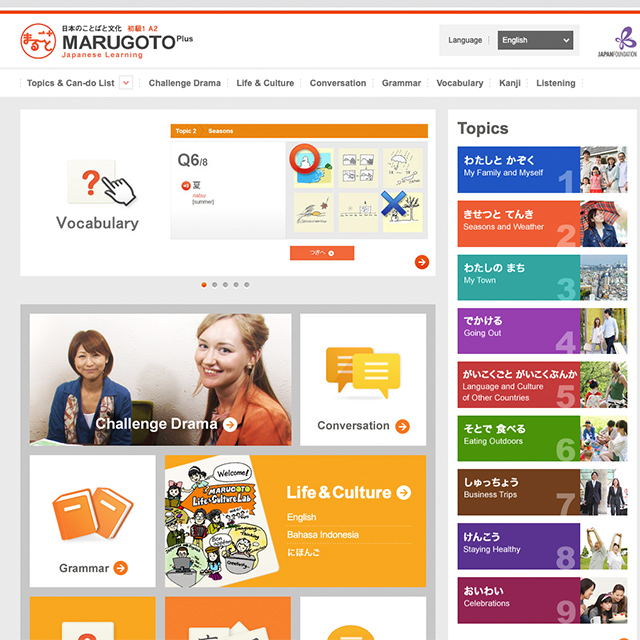
Like the A1 website, A2 MarugotoWeb is a fantastic place to practice the Can-Dos amongst other aspects of language. Each Can-Do topic contains a Challenge Drama that lets you actually practice your skills, similar to the challenge videos on the previous set's website. There is also an impressive Life and Culture Lab where you can view a multitude of videos and posts not only about Japanese culture, but other cultures as well. The articles are set up like social media posts with "comments" and the ability to like posts. It's an interesting way to immerse yourself in Japanese language and culture. You can also try the Conversation section, as well as the grammar, vocabulary, kanji, and listening sections to practice those skills.
Useful Links
- Accompanying Website: A2 MarugotoWeb
- Can-Do List: Katsudoo and Rikai
- Vocabulary Index: Katsudoo and Rikai
- Phrase Index: Katsudoo and Rikai
- Audio Files: Katsudoo and Rikai (Account login required.)
- Kanji Index: Rikai
- Amazon.co.jp:
- Amazon.com:
Marugoto: Elementary 2 (A2)
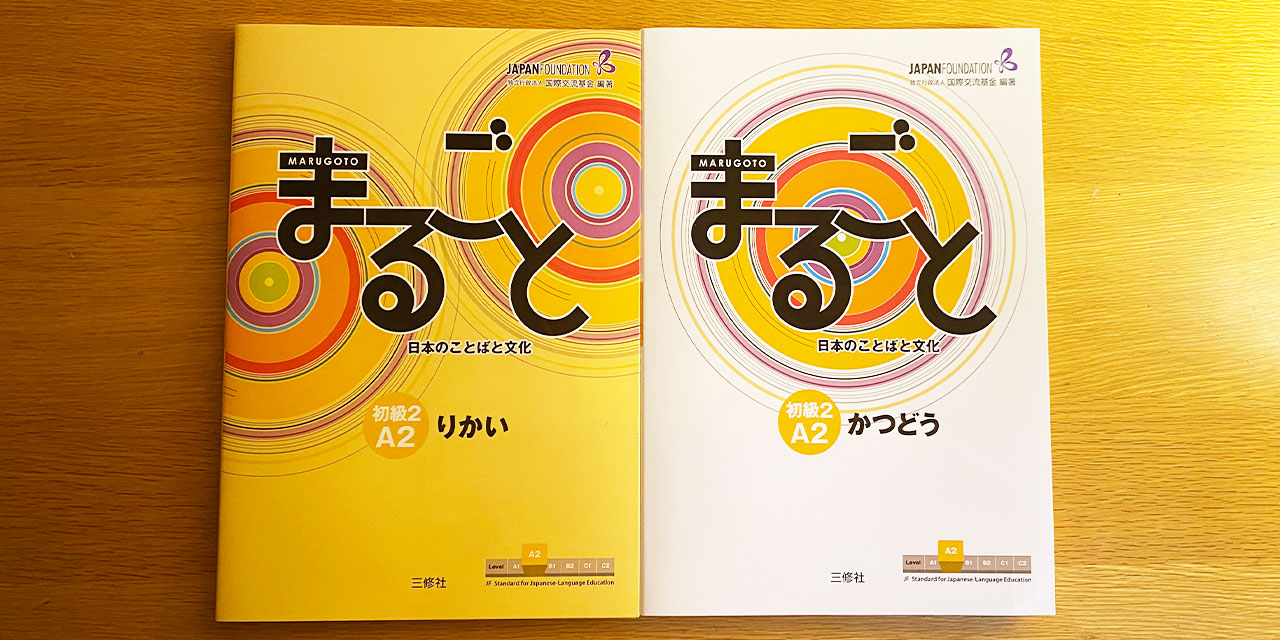
The organization and setup of this set is identical to the previous set. The only difference is a jump in complexity of the content. If you ever wanted to visit a Japanese restaurant and read a vertical menu, then Can-Do 6 in chapter 2 would suit your needs well! And for any museum lovers out there, Can-Do 39, "tell a friend in simple terms what the description of an exhibit in a museum says," would prove useful. All of these skills, and forty-seven others, form the outline for content at this level.
Digital Content for Marugoto: Elementary 2 (A2)

The accompanying website for the Elementary 2 books, A2-2 MarugotoWeb, arguably looks the most modern of the websites viewed so far. The conversation videos are a drama series with an interesting cast. There are 18 episodes, each corresponding to one lesson and covering multiple Can-Dos. On the site, you can also practice kanji and grammar. And like the previous sites, there are also several cultural videos as well as the "Life and Culture Snap" pages that give short, social media post-style articles about a particular topic. These short "snaps" are written in all Japanese with the option to include furigana (kanji pronunciations) as well — truly a great resource for intermediate students looking to practice their reading abilities.
Useful Links
- Accompanying Website: A2-2 MarugotoWeb
- Can-Do List: Katsudoo and Rikai
- Vocabulary Index: Katsudoo and Rikai
- Phrase Index: Katsudoo and Rikai
- Audio Files: Katsudoo and Rikai (Account login required.)
- Kanji Index: Rikai
- Amazon.co.jp:
- Amazon.com:
Marugoto: Pre-Intermediate (A2/B1)

From this level on, the content organization and setup drastically changes. For starters, there is only one book for the level. Furthermore, you will notice that this book corresponds to both the A2 and B1 levels. It acts as a bridge between both levels, which is why Marugoto labeled it as the "Pre-Intermediate" book. All types of activities have been included in this text: reading, writing, speaking/conversation, listening, and so on. The portfolio feature is also brought back to help you keep track of your learning.
In this textbook, the two-lesson structure contained within a single topic is replaced by a single-topic structure with only one lesson. According to the Features section of the book, each topic (there are nine in total) should take a learner approximately six to eight hours to complete. Within each topic, there are five or six parts. Part 1 is a Preparation section designed to garner interest in the topic using pictures, and presents the vocabulary and Japanese characters necessary for understanding the topic. Part 2 eases the learner into the topic through short listening and conversation activities. Part 3 continues listening practice in the topic by introducing a longer listening activity along with a script. Longer conversations and note-taking are also encouraged. Part 4 focuses on short readings and grammar pattern practice. And finally, Part 5 (and sometimes Part 6) finishes the topic with a longer reading passage and conversation activities related to the corresponding reading.
One other major difference you might notice while using the intermediate-level books is the lack of an accompanying learning website with content similar to the earlier books. While it would be nice to have something like that for the intermediate levels, for whatever reason, the Marugoto team decided not to implement it. Instead, the intermediate levels retain the high-class native audio files for download, word lists with pitch accents, script and text translations in English, learning records, and writing sheets.
Skills you will see highlighted at this level include things like Can-Do 14, "read an article from a website and understand what the writer says about the food he/she cannot live without," and Can-Do 42, "talk about the company you work for and the work you do." And, as stated previously, while the Marugoto series is not aimed at helping you pass a test like the JLPT, once you complete this level, you should be prepared to pass the N4 level of the exam.
Useful Links
- Can-Do List: Can-Dos
- Vocabulary Index: Vocabulary
- Phrase Index: Phrases
- Audio Files: Audio (Account login required.)
- Kanji Index: Kanji
- Amazon.co.jp:
- Amazon.com:
Marugoto: Intermediate 1 (B1)
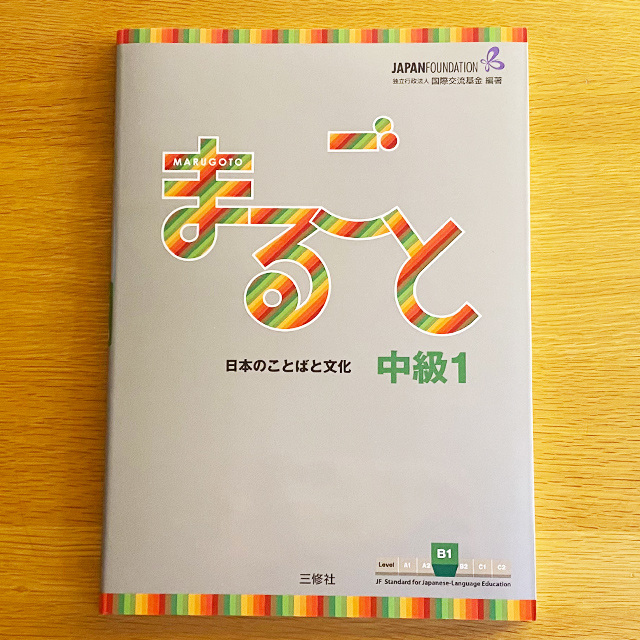
The Intermediate books are formatted in a very similar fashion to the previous set: there are nine topics, each with five parts — six if you count the Preparation found at the start of each topic. Part 1 focuses on listening skills. Part 2 is all about holding a conversation. Part 3 helps you to talk more about the topic at length. Part 4 helps train your reading abilities. And finally, Part 5 gets you to write about the topic at hand. There's also an interesting "Outside the Classroom" section at the very end of each topic that is designed to get the learner using Japanese in a number of non-classroom environments. Things like Facebook, YouTube, posters, apps, and other platforms are utilized for this purpose.
Unlike the previous books, however, the Intermediate textbooks do not integrate an assessment directly into the lesson flow. Instead, suggested assessments and their guidelines are presented in the very back of the book. This is also where you can find answer keys, audio scripts, and personal learning records. Because of the amount of content and time it takes to go through everything, Marugoto suggests assessing learners with a Test and Reflection after every three topics covered. This means that intermediate learners using Marugoto are recommended to have three assessments while using this textbook.
Building upon the major changes discussed so far, the overall goals of the intermediate books are drastically different as well. According to the Features section in both intermediate texts, there is now an emphasis on "strategies" that learners can use to help them comprehend and use Japanese in real life. According to the books, these include things like:
- Guessing the meaning of unknown words
- Replacing unknown words with known ones
- Using confirmations to check understanding and keep the conversation flowing
Some of the skills you will see practiced in this book include things like talking to a friend about their musical tastes (Can-Do 12), discussing one's hopes and plans for a trip (Can-Do 18), listening to someone talking about a manga and understanding what kind of story it has (Can-Do 26), and even writing about a product you are looking for on a site that Japanese people tend to use (Can-Do 40).
Useful Links
- Vocabulary List: Vocabulary
- Audio Files: Audio (Account login required.)
- Amazon.co.jp:
- Amazon.com:
Marugoto: Intermediate 2 (B1)
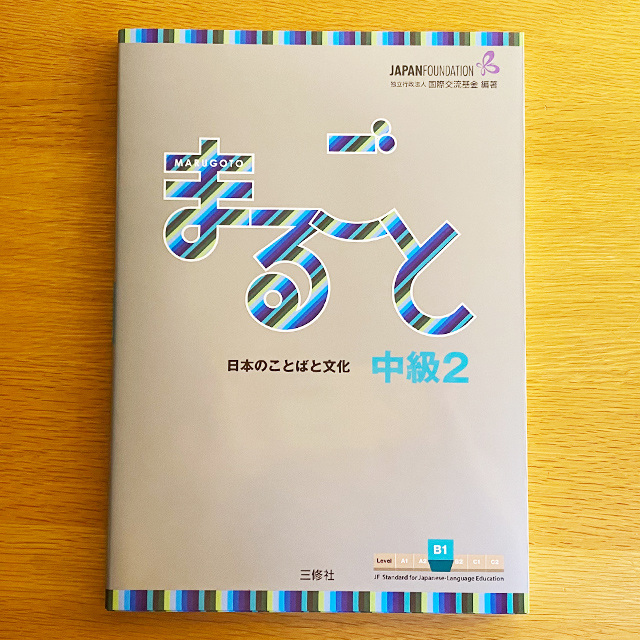
The Intermediate 2 book is organized exactly the same as the Intermediate 1 book. The only differences are between the content and overall difficulty. While Marugoto claims this book is only at the B1 level, there are those who would argue it is partly at the B2 level as well. Upon completion of this level, learners should have a solid foundation for passing the N3 level of the JLPT.
Examples of some skills you will see in this book include things like giving advice on how to stay healthy (Can-Do 12), reading online shopping reviews (Can-Do 29), and talking about historical buildings and how they came to be (Can-Do 43).
Useful Links
- Vocabulary List: Vocabulary
- Audio Files: Audio (Account login required.)
- Amazon.co.jp:
- Amazon.com:
The Verdict: Best Japanese Learning Curricula in Group Settings

To sum everything up, Marugoto is truly a complete package when it comes to learning Japanese. Its vibrant design, interactive components, and range of levels are great for both absolute beginners and upper intermediate students alike.
Learners of Japanese trying to get into the Marugoto curriculum may not know about the accompanying websites, native audio files, or wordbooks that are truly necessary for a full learning experience.
Personally, I think Marugoto is one of the best Japanese language-learning curricula out there. Since I discovered it and its suite of content, I have exclusively used Marugoto when teaching Japanese in a group setting. And that is exactly where it shines: the guided group setting. Unfortunately, Marugoto may be a little out of reach for self-learners who are unfamiliar with its design and implementation. And by "out of reach," I am referring to the way in which Marugoto recommends its instructors go about teaching with the books and accompanying media. Typical lessons, for example, only have about three activities on average. If a self-learner who had no Marugoto training looked at these books, they may mistakenly believe that there is really no substance to the lessons. Furthermore, learners of Japanese trying to get into the Marugoto curriculum may not know about the accompanying websites, native audio files, or wordbooks that are truly necessary for a full learning experience.
If you are a self-learner, my advice would be to find an instructor-led course that utilizes Marugoto or to even check out the Marugoto Online Course. The Marugoto Online Course uses the same content as the textbook series (at least for the A1 and A2 levels) and guides students through the content. This means there is no setup hassel or even the need for learning how to implement the curriculum.
David’s Review
I think this is one of the best curricula out there. In the classroom, lessons are fluid and interactive. Plus, the bite-size amount of content as well as digital components are perfect for my beginner students. And with their emphasis on teaching the language through a Japanese cultural context, my students seem more and more intrigued about life in Japan after each lesson. Thanks to these textbooks, I have actually had standing ovations at the end of some of our lessons before!
